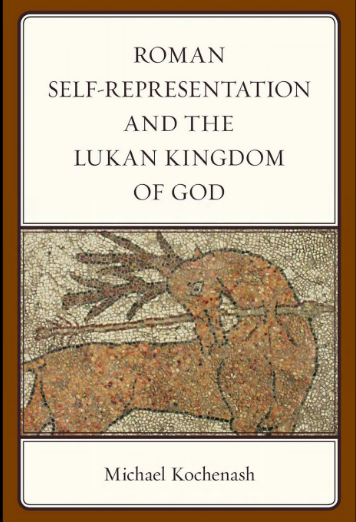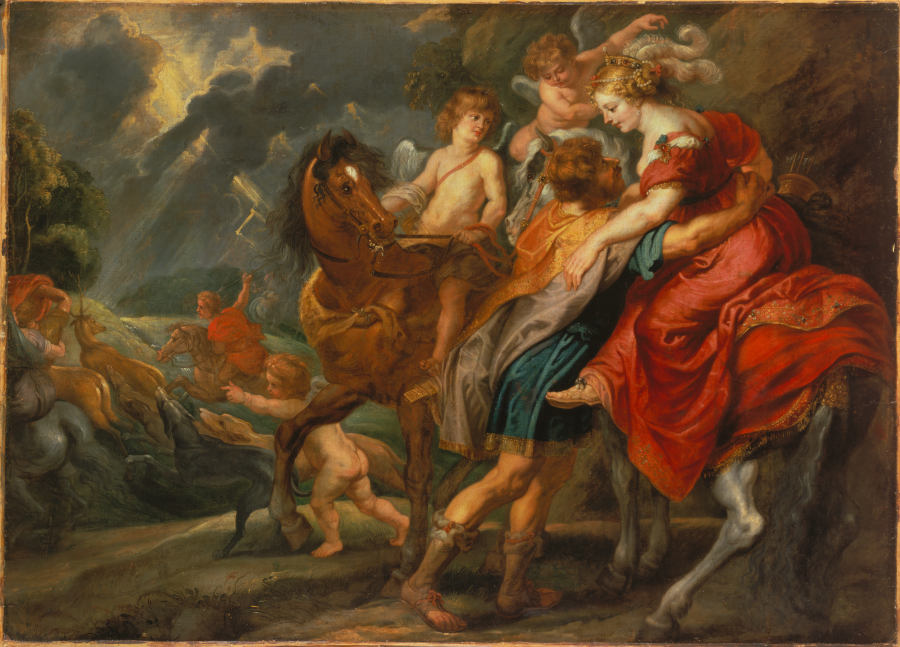 So I have not been the only one to pick up on the meaning of the name of a woman Peter raised from the dead and associate it with Virgil’s Aeneid. Her name is given as Dorcas, meaning a “deer”, and her healing follows immediately after Peter’s healing of Aeneas. Michael Kochenash has written a chapter on the same intertextual link in Roman Self-Representation and the Lukan Kingdom of God.
So I have not been the only one to pick up on the meaning of the name of a woman Peter raised from the dead and associate it with Virgil’s Aeneid. Her name is given as Dorcas, meaning a “deer”, and her healing follows immediately after Peter’s healing of Aeneas. Michael Kochenash has written a chapter on the same intertextual link in Roman Self-Representation and the Lukan Kingdom of God.
We have a different emphasis, though.
In Acts, Peter raises from the dead a well-loved disciple named Tabitha, “Greek name Dorcas”, who had won renown for her caring work of making woven clothes. This scene takes place on the cusp of expanding the Christian mission from the Jews to the gentiles. Since that miracle took place just after the healing of Aeneas, the namesake of the famed mythical founder of the Romans, I was reminded of the dramatic scene in Virgil’s Aeneid where a slain deer is the cause of war between Aeneas’s company and the Latins. It was that war that marked the beginning of a place for the ancestors of Rome in Italy. Like Dorcas, the deer was well-loved by all around her and associated with woven decoration.
Acts 9:
32 As Peter traveled about the country, he went to visit the Lord’s people who lived in Lydda. 33 There he found a man named Aeneas, who was paralyzed and had been bedridden for eight years. 34 “Aeneas,” Peter said to him, “Jesus Christ heals you. Get up and roll up your mat.” Immediately Aeneas got up. 35 All those who lived in Lydda and Sharon saw him and turned to the Lord.
36 In Joppa there was a disciple named Tabitha (in Greek her name is Dorcas); she was always doing good and helping the poor. 37 About that time she became sick and died, and her body was washed and placed in an upstairs room. 38 Lydda was near Joppa; so when the disciples heard that Peter was in Lydda, they sent two men to him and urged him, “Please come at once!”
39 Peter went with them, and when he arrived he was taken upstairs to the room. All the widows stood around him, crying and showing him the tunics and other clothing that Dorcas had made while she was still with them.
40 Peter sent them all out of the room; then he got down on his knees and prayed. Turning toward the dead woman, he said, “Tabitha, get up.” She opened her eyes, and seeing Peter she sat up. 41 He took her by the hand and helped her to her feet. Then he called for the believers, especially the widows, and presented her to them alive. 42 This became known all over Joppa, and many people believed in the Lord.

Virgil’s epic poem about the odyssey of Aeneas from Troy to Italy where he founded the settlement that would become Rome sustains the image of deer throughout books 1, 4, 7, 10 and 12. A crisis in the epic occurs when Aeneas is in danger of being diverted from his divine mission by falling in love with Dido, the queen of Carthage. After Aeneas finally breaks free and leaves for Italy, the distraught Dido kills herself with the sword Aeneas had gifted her. Kochenash discusses at some length the deer similes in these episodes and their resonances in the Acts passage that I had completely overlooked. The emotionally wounded Dido is compared to a wounded deer. Her death is caused by Aeneas in two senses: by his leaving her and by her taking the sword he had left her. The metaphor Virgil uses is that of arrows of the hunter slaying the deer, an ironic twist on the arrows shot by Cupid.
There are other deer comparisons in the Aeneid that Kochenash addresses in the same context. One of these is the climactic end of the epic where Aeneas, compared with a savage hunting dog, slays the king Turnus who is likened to a helpless deer.
What does all of this have to do with Acts and Peter’s healing of Dorcas, apart from the fact that Dorcas means “deer”?
First of all, the author of Acts drew special attention to the name Dorcas by presenting it as a translation of the Aramaic Tabitha. Secondly, and I think most significant, is that the healing happens at Joppa, the place known from the story of Jonah who took God’s message to the gentiles of his day. Jonah tried to flee from his task by taking a ship from Joppa but God redirected him back to Assyria. And third, the reader is primed to “think Roman” by the immediately preceding healing of Aeneas.
Or in Kochenash’s words,
The three Petrine narratives within Acts 9:32–11:18 represent a transition in the mission of the kingdom of God: the inclusion of those beyond the margins of Jewish religion and society (i.e., Gentiles). Tabitha lives in the city of Joppa, a detail emphasized by Luke to foreshadow the Gentile mission that begins in the next narrative. The tragedy of Dido reflects a Roman attitude that human life is expendable when it impedes the progress of Rome’s empire. When Luke’s Peter is thus read as contrasting with Virgil’s Aeneas in a pivotal narrative concerned with the expansion of the kingdom of God, the character of God’s kingdom becomes evident by contrast to that of Rome.
This interpretation coheres with a Greco-Roman literary ethos, wherein Greek writers relished the opportunity to encrypt arcane messages within their narratives. While a general readership would be able to read the narrative with sufficient comprehension, those with the appropriate cultural competence would enjoy noticing the subtle references that augment such a reading. According to Dennis R. MacDonald, “In most cases, imitations disguise a rewarding sensus plenior—a fuller meaning below the surface, somewhat like allegory—that is intended for the more sophisticated. Discovering a clever, obscure twist on a popular tale often produces a smile, as though in the cryptic allusion the author has winked.” Luke’s use of the names Tabitha and Dorcas—in proximity to the name Aeneas—can, I suggest, be read as a wink to his readers. (p. 116 – author link is to the cited work in archive.org)
Here is Kochenash’s summary of his longer discussion:
The Romans could not completely obscure the fact that its touted Pax came at the expense of (human) collateral damage. Even Rome’s foundation epic, Virgil’s Aeneid—written under the patronage of Augustus himself—includes two such fatalities: Dido and Turnus. According to Mary Thornton, by comparing these two to deer, “Vergil is guaranteeing that although we see the faults and the responsibilities of Dido and Turnus for their misfortunes, we will not fail to give them our sympathy just as we would do for any wounded deer.” Luke’s narrative constructs a matrix consisting of a man named Aeneas, a dead woman whose name means “deer,” and the theme of the expansion of the kingdom of God, all of which can be read as an allusion to the tragedy of Aeneas and Dido. This allusion prompts readers to understand the kingdom of God through the framework of Roman self-representation. By raising Tabitha from the dead, Peter enacts the expansion of the kingdom of God, performing an action that has the opposite effect of Roman expansion. Whereas the expansion of the Roman Empire brings death, that of the kingdom of God brings life. (p. 118 – author link is to the cited work in Jstor)
Even if many of the early readers of Acts had not read Virgil’s Aeneid the stories of Aeneas and Dido were well known throughout the empire as artworks and papyri remains testify.
There is one detail, however, that I do find myself wondering if Kochenash has overlooked. Why does Acts point out all of the garments that Dorcas had made? Continue reading “The Deer in Acts of the Apostles and the Aeneid”
